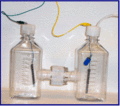Microbial Fuel Cells
Microbial fuel cells are a new way to generate electricity. They use the activity of bacteria to create a potential difference between two chambers. All bacteria metabolize chemicals in their environment and there are often leftover electrons from these processes. A few kinds of bacteria can be persuaded to deposit these onto an electrode placed in their environment.
A microbial fuel cell has a cathode and an anode. Bacteria live in the anode, where they eat glucose, sewage, or other waste. They form a film on the electrode, and when they break down the waste, they produce a current in the wire running out from the electrode.
A wire that runs between the two chambers will have an electric current running along it. You can generate about 1kW from a cubic meter of dirt in this way. (The record is 2.3kW per cubic meter - think you can beat that?)
Microbial fuel cells can be run on dirt, wastewater or other organic matter. There is a variant called a microbial electrolysis cell that splits water to create hydrogen, rather than generating electrical current. Another variant is the microbial desalination cell. This takes saltwater, splits the salt into sodium and chlorine ions, and uses the potential difference between these ions to generate electric current. Create clean energy while desalinating water - how excellent is that? [1]
MIT Technology Review article on MFC [2]
In theory, you could build one into your compost heap and make that generate electricity, though there don't seem to be reports of people doing this. Someone must try this.
How to make one
To make a microbial fuel cell, you put graphite cloth - the anode - in the bottom of a bucket along with chicken wire - the cathode - and microbe-laden waste, either mud, cow manure, or residue from coffee crops. A layer of sand acts as an ion barrier while salt water helps the protons travel more easily. you also can add a power management board to regulate the power and send it to a battery. Such a fuel cell can run a cheap, efficient light-emitting diode (LED) for four to five hours per evening. A system like this will cost around $10.
Instructions on building your own
From the OSE perspective, it would be good to condense all of these into a bill of materials, clear instructional video etc.
- Instructables Part 1 (lost), Part 2 and Part 3
- Six part YouTube tutorial
- You definitely need to watch this lecture by Bruce Logan. It gives a bunch of tips on how to maximise power production from your microbial fuel cell and also explains how to make microbial electrolysis cells and microbial desalination cells. It condenses several years of research into an hour.
- A page on the igem Team:Bielefeld http://2013.igem.org/Team:Bielefeld-Germany/Project/Abstract with design files for 3D printing MFCs parts http://2013.igem.org/Team:Bielefeld-Germany/Project/MFC#Do_It_Yourself
- vanished pages in the archive: fuel-web.net, fuelcelltoday.com
See also
The following dead links from microbialfuelcell.org were corrected using the 'way back machine' from archive.org:
- Make a Microbial Fuel Cell - Interested in building a Microbial Fuel Cell yourself? Several students, in middle schools, high schools, and in College, have already had lots of fun with this project (see links below). We have even included some general guidelines to help get you started if you are interested in making your own. (MFC gives CV sophomore a charge)
- Design of a Single Chamber Microbial Fuel Cell - pdf (1.40 mb), Eric A. Zielke, Humboldt State University
- Probabilistic Analysis of a Monod-type equation by use of a single chamber Microbial Fuel Cell - pdf (374kb), Eric A. Zielke, Humboldt State University
- Probabilistic Analysis of a Monod-type equation by use of a single chamber Microbial Fuel Cell, pdf (1021kb), Eric A. Zielke, Humboldt State University
- Thermodynamic Analysis of s single chamber Microbial Fuel Cell, pdf (707kb), Eric A. Zielke, Humboldt State University
- Numerical Analysis of a one dimensional Diffusion Equation for a single chamber Microbial Fuel Cell using a Linked Simulation Optimization (LSO) technique, pdf (924), Eric A. Zielke, Humboldt State University

